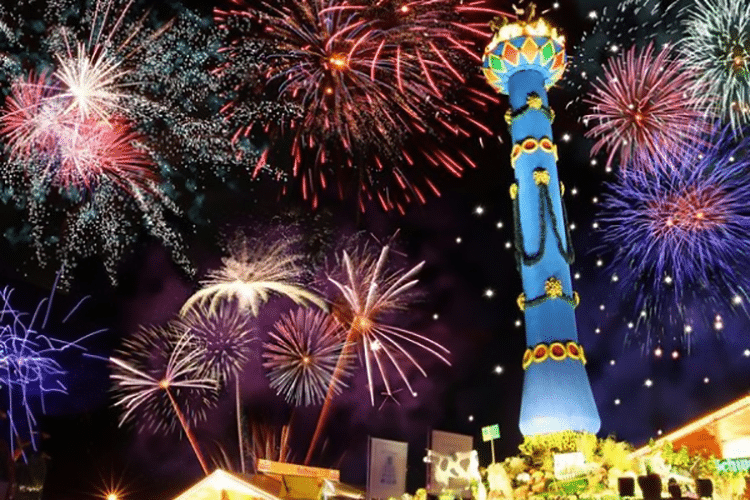Germans sure know how to throw a party. Fun festivals with oom-pah bands, beer, wine, sausages plus all sorts of tasty edibles — and plenty of gemütlichkeit. There really is no accurate translation for this word which describes the jolly ambience and lively spirit that is the essence of these celebrations. There’s even a toast to gemütlichkeit, “Ein Prosit, Ein Prosit der Gemütlichkeit” sung over and over at fests as folks raise their mugs, steins or glasses. Munich’s Oktoberfest is known the world over, but there’s so much more. One source claims there are 10,000 different fests in Germany every year celebrating beer, wine, sausage, onions, garlic, music, dance, saints, holidays; the list goes on.
Many, many years ago shortly after moving to Germany I joined friends to take in the wine fest in the town of Bad Durkheim on Germany’s Wine Road. Its proper name is the Durkheimer Wurstmarkt, literally sausage market, yet it is the world’s largest wine festival with some 600,000 visitors every year. I was overwhelmed. Wine is served in large half liter glasses. Rousing music. Long tables in tents where folks link arms and sing – and welcome strangers. Much more than sausage to eat. Rides. Fireworks. Games. Everyone in a party mood. It’s fun, fun, fun. I was hooked on German fests then and have been to many over the years.

Like most German fests, the Bad Durkheim festival has its roots in ancient customs and traditions. Some 600 years ago it was a meeting point for local farmers and winegrowers, attracted by the pilgrims who came to the small chapel on top of the mountain “St. Michaelsberg” every year. Centuries later the religious event became a folk festival held the 2nd and 3rd weekends in September. It takes place in the town around a giant cask, the Durkheimer Riesenfass, – the largest wine barrel in the world, which also houses a restaurant. Bad Durkheim is in Germany’s Rhineland Palatinate, the country’s second largest wine growing region. It may be the largest, but throughout Germany’s wine regions fests in honor of the grape and its bounty abound both in tiny villages as well as major towns. “We like visitors, parties, festivals. We like to share with others; every weekend you can find a wine fest somewhere,” vintner Martin Bercher in the village of Burkheim told me on a recent visit to Germany’s Baden wine region.
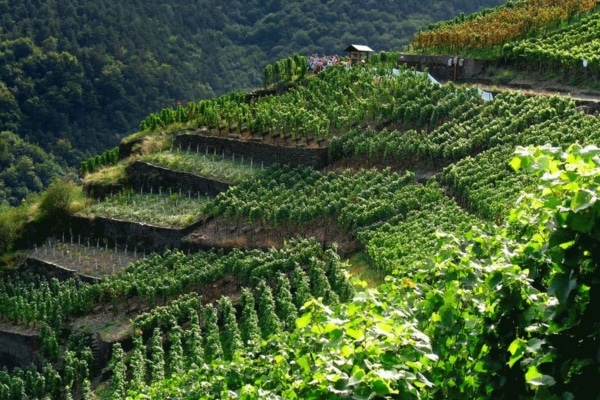
That sums up a German’s attitude about festivals. It’s in their DNA. German friend Ortrud Hundertmark now lives in France but returns to Germany two to three times every year to attend festivals. “If I could not go back, I would get sick,” she says. The fests are occasions to see friends, many whom you don’t see regularly but who show up to party. “It’s being together, sometimes singing and dancing, always having fun,” she explains.
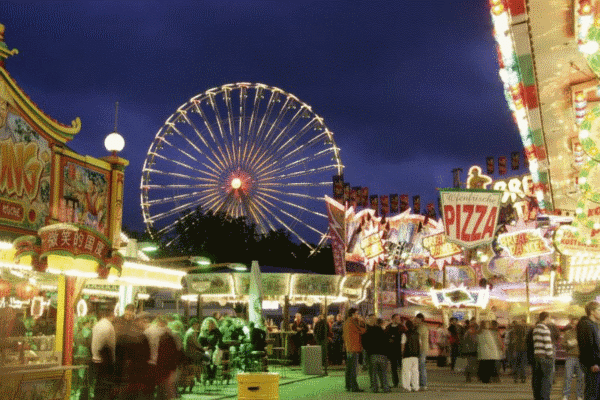
Throughout the country, every town and region lays claim to distinct festivals. Ortrud’s husband Kurt would not miss the Schutzenfest in his hometown of Neuss in northern Germany. This marksmen’s festival held the last weekend of August every year dates back to the Middle Ages when it was military in nature. Today some 7,000 members of the Neuss’ citizens’ marksmen’s association, including Kurt, wear uniforms and march in parades and processions to carry on their town’s ancient tradition. There are tents with beer, music, dancing and a shooting competition. About a million visitors attend the Neuss event ever year. Hannover also has a Schutzenfest which is even larger than the one in Neuss.
During my many years in Germany, I was a regular at the annual fests in the different towns where I lived. Darmstadt hosts the Heiner fest every summer in early July when the entire inner city is closed to traffic for five days. Crowds pack the streets to browse the numerous stands. There are also game stands at this festival, as well as at most others, and it’s not unusual to see folks in the crowd carrying huge stuffed animals they’ve won.
Nearby Griesheim has its Zwiebelmarkt, literally onion market, held annually at the end of September. During the 16th and 17th centuries the tiny burg adjacent to Darmstadt produced wine, but after the 30 years war, produce, namely onions, replaced the grapes. Of course, the onion stars in this food fest with Zwiebelkuchen (onion tart) the favorite, usually consumed with a glass of Federweisser, a type of new wine. The name translates as “feather white” referring to the milky appearance of the beverage due to suspended yeast; it is not a finished wine, but fermented freshly pressed grape juice.
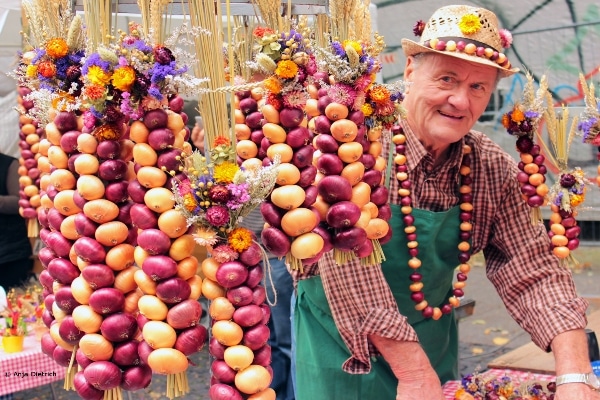
Weimar also has an onion market in early October that has been on the calendar since 1653 and all things dedicated to onions are honored. Take home an onion souvenir – a colorful onion braid decorated with dried flowers. Market stalls in the town center offer traditional handicraft and agricultural products. There’s also plenty of liquid refreshment plus several stages for entertainment and music.
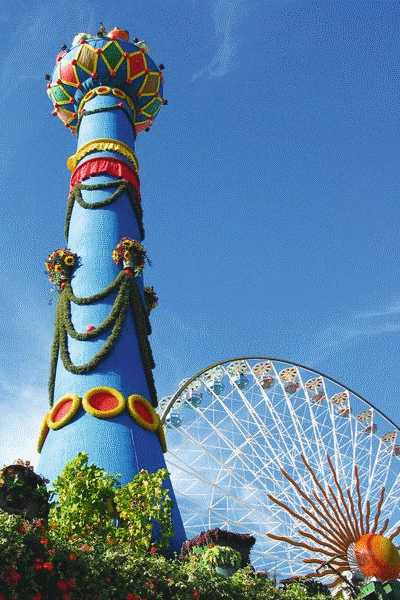
Stuttgart, where I lived for several years, may take the prize for the most fests and the biggest, too. Its annual fall beer festival, the Cannstatter Volksfest, is the second largest after Oktoberfest, attracting millions who quaff beer in liter mugs. Founded by King Wilhelm 1 in 1818, it was originally a harvest festival and in keeping with its origins a 26-meter column of fruit towers over the fairgrounds. Lasting for 17 days, it features gargantuan beer tents sponsored by different breweries, each seating 5,000 revelers. It’s all rollicking good fun and sometimes fest goers are so moved by the ambience, they hop atop the tables and dance. A popular food to soak up the beer is spit roasted chicken. There’s even a chicken tent, Festzelt Göckelesmaier, named after its chicken, Swabian Göckele. The mouth watering aromas of the grilled birds drift over the festival grounds. It’s hard to resist.
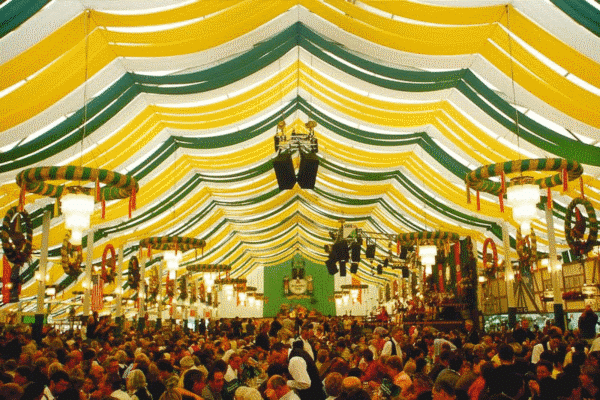
“Volksfest has definitely been one of the highlights of my three years here in Stuttgart,” an American working for the military in Stuttgart once told me. “At first I was bit intimidated by the large crowds of people singing and standing on tables. But I quickly discovered that everyone is really friendly, and people went out of their way to talk to me in spite of my limited language skills. In my second year I even worked up the courage to wear a traditional dirndl, which really made me feel like one of the locals!”
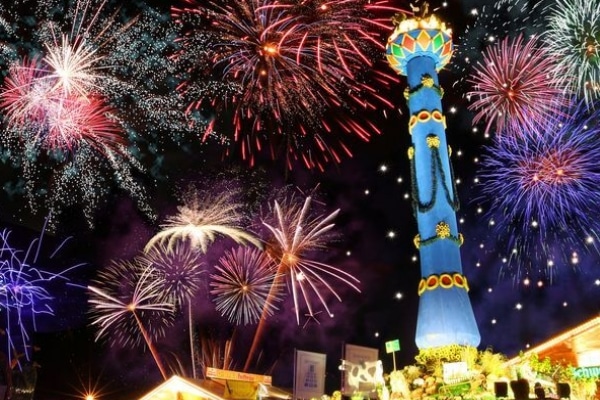
My favorite Stuttgart festival, a bit less raucous in tone, is the Weindorf or Wine Village which is held in the town center in late summer. It features numerous vintners selling their wines and is a great way to try different vintages and indulge in some of my favorite Swabian foods. You can savor Maultaschen, succulent Swabian ravioli served in a broth or fried with onions; Käsespätzle, Swabian noodles with cheese; and Buben Spitzle which are mini potato dumplings with sauerkraut and bacon bits.
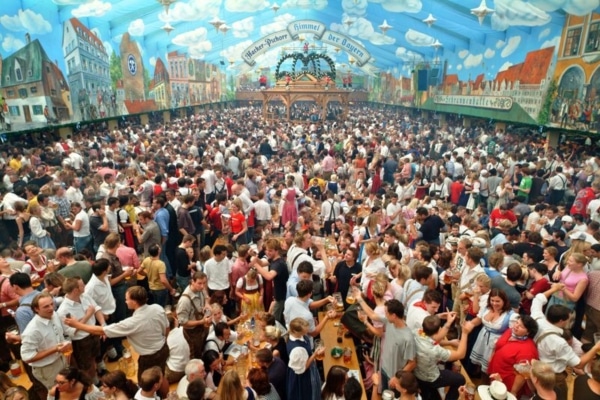
The Oktoberfest, the king of Germany’s festivals, began as a celebration of Bavarian Crown Prince Ludwig’s marriage to Princess Therese von Sachsen-Hildburghausen in 1810. It draws huge crowds, up to seven million each year, who come from all over the world. In the beer tents they link arms with locals and down German beer in liter mugs, sing, enjoy carnival rides, and munch on Bavarian specialties such as sausage and pretzels. Costumes play a role in this Bavarian celebration with locals and visitors alike often clad in traditional garb — lederhosen for men and dirndls for women.
Bavarians love to party and celebrate beer again with the Strong Beer (Starkbier) Festival in March honoring a special brew. Monks get credit for this one. In 1651 the Paulaner brothers-of-the-cloth started brewing strong beer which they called Flüssiges Brot (liquid bread). Thanks to the hearty brew they were able to fast for the 40 days of Lent with full bellies and in good spirits. Bavarian rulers decided the monks were on to something, and in 1751 the first public strong beer festival got underway. Today the original and biggest party is at the Paulaner “Nockherberg” brewery south of Munich. The atmosphere is very much like Oktoberfest with thousands of visitors – many in traditional Bavarian outfits – packed into a huge hall and dancing on the benches to modern and old-time German hits. Beer is served by the liter in ceramic steins called Keferloher.
On the Christian calendar the period just before Lent is traditionally a time of celebration before the somber season begins. In many parts of Germany pre-Lenten Carnival celebrations are more than festivals with huge bashes, costume balls, dances and parades over a period of a few days to several weeks before the Ash Wednesday start. Mainz, Düsseldorf, Cologne and many towns in the Black Forest hold huge parades.
Germans celebrate much more than beer, wine and food. Music – from rock to opera – is feted at events throughout the country and the tone of the celebrations varies with the music. Rock is the focus at Rock in the Ring and Rock in the Park, two simultaneous rock music festivals held annually. The Ring festival is held in Mendig at an old airbase near Koblenz while Rock in the Park takes place in southern Germany at the Zeppelinfeld in Nuremberg. Both are usually regarded as one event with a mostly identical lineup. Combined, they are the largest music festivals held in Germany and one of the largest in the world.
Well known to opera fans is the Bayreuth Festival in the city of the same name. This festival has become a destination for lovers of the 19th-century German composer Richard Wagner. Wagner himself conceived and promoted the idea of a special festival to showcase his works, in particular his monumental cycle Der Ring des Nibelungen and Parsifal.
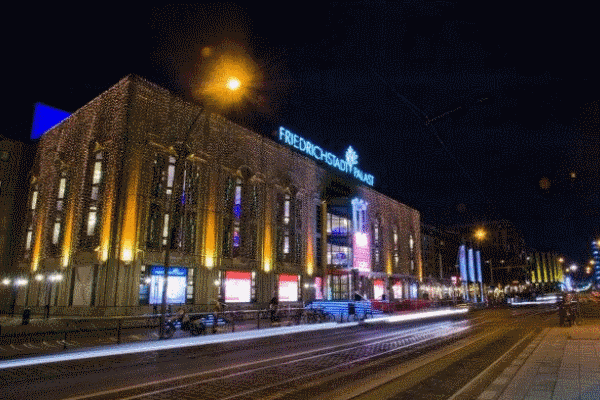
Germany also has a noted film festival, the Berlinale, held every February when Berlin rolls out the red carpet to host the Berlin International Film Festival. More than 400 films from all over the world are shown, along with parties and special events for film lovers. Berlinale is the most important film festival in Europe after Venice and Cannes.
This is but a sampling of German festivals. Wherever you find yourself in Germany, inquire at the local tourist office about fests. You are sure to find one and enjoy the gemütlichkeit.
I miss them terribly, having moved to France several years ago. Sure, there are fests here, but quite disappointing compared to the gemütlich gatherings in Germany. Time and again my husband and I have headed off to a French fest only to come home missing Germany. Most festivals here have very few food stands and of course, no beer tents. And no music. And, no gemütlichkeit! I might have to join my friend Ortrud soon for a few trips back to Germany each year.
For more information on the fests mentioned see the following sites. Some are only in German. However, if you google the name of the town and festival, you’ll find English language sites with more information.
Bad Durkheim wine festival, Sept. 9 -13 and 16-19, 2016: www.bad-duerkheim.com
Neuss Schutzenfest, Aug. 26 -30, 2016: English city site: www.neuss.de German site: www.schuetzenfest-neuss.com
Darmstadt Heinerfest, June 30 – July 4, 2016: www.darmstadt.de and fest site in German, www.darmstaedterheinerfest.de
Griesheim: www.griesheim.de
Weimar Onion Market: www.weimar.de
Stuttgart Volksfest, Sept. 23 – Oct. 9, 2016: www.cannstatter-volksfest.de
www.germany.travel/stuttgart-volksfest
Stuttgart Spring Festival, April 16 – May 8, 2016: www.stuttgarter-fruehlingsfest.de
Stuttgart Wine Village, Aug 24 – Sept 4, 2016: www.stuttgarter-weindorf.de
Oktoberfest, Sept. 17 – Oct. 3, 2016: www.oktoberfest.de
Munich Strong Beer Festival: www.destination-munich.com
Rock in the Ring, June 3 -5, 2016: www.rock-am-ring.com
Rock in the Park, June 3 – 5, 2016: www.rock-im-park.com
Bayreuth Festival, July and August, 2016. See program on this site: www.bayreuther-festspiele.de
Berlinale (Berlin Film Festival), Feb. 11 – 21, 2016: www.berlinale.de

